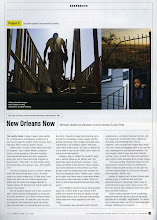 What has surprised me most here was the scale of the disaster, and the people of New Orleans. From the citywide tour on Monday, to day after day during the week, seeing the houses, businesses, infrastructure... so much destroyed.
What has surprised me most here was the scale of the disaster, and the people of New Orleans. From the citywide tour on Monday, to day after day during the week, seeing the houses, businesses, infrastructure... so much destroyed.The people; kindness, openness, resilience. 938 days later so much
has been built, but so much has yet to be done.

The people that I have met have affected me most. They have been through so much, and are
so positive and full of hope. We met a woman yesterday, that was 89
years old, and evacuated through her kitchen window (during the flood after Katrina) onto a boat. She
lost everything material...in the following couple years, she lost her
brother, and son to various illnesses. She invited us all in (a eight
people) her new house, even though she hadn't showered or changed out
of robe yet. She offered coffee, or to fix us something. when we
left she told us to be safe and to travel in two's or three's, and
said God Bless.
Yesterday was of the best afternoons all around. I wanted to go to the west end. 3 students came along, Beth, Anthony and Liz. We checked out were the levee broke, the pumping station, and than came across a house that looks untouched since the hurricane, (even though it was near a busy intersecti
 on). Children's toys scattered about, a family album, piano, silt all around, rooms with tumbled mixed up furniture. We met a family from a neighboring suburb, that came by to appreciate that even though they'd lost half their house, they were fortunate.
on). Children's toys scattered about, a family album, piano, silt all around, rooms with tumbled mixed up furniture. We met a family from a neighboring suburb, that came by to appreciate that even though they'd lost half their house, they were fortunate. I'm quite impressed with the work of all the students, one is cut out for this type of shooting, another has been passionate in experimenting in pushing for the best light, and taking advantage of shooting opportuniti
I'm quite impressed with the work of all the students, one is cut out for this type of shooting, another has been passionate in experimenting in pushing for the best light, and taking advantage of shooting opportuniti es, another has been great at approaching strangers, and one has been looking at breaking all illusions of how we make these images, by photographing the photography.
es, another has been great at approaching strangers, and one has been looking at breaking all illusions of how we make these images, by photographing the photography.Rich Ryan


























